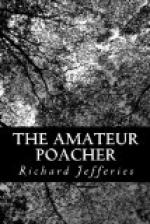But the enclosure of open lands, the strict definition of footpaths, closer cultivation, and the increased value of game have so checked the poacher’s operations with nets that in many districts the net may be said to be extinct. It is no longer necessary to bush the stubbles immediately after reaping. Brambles are said to have been the best for hindering the net, which frequently swept away an entire covey, old birds and young together. Stubbles are now so short that no birds will lie in them, and the net would not be successful there if it were tried.
The net used to be so favourite an ‘engine’ because partridges and pheasants will run rather than fly. In the case of partridges the poacher had first to ascertain the haunt of the covey, which he could do by looking for where they roost at night: the spot is often worn almost bare of grass and easily found. Or he could listen in the evening for the calling of the birds as they run together. The net being set, he walked very slowly down the wind towards the covey. It could not be done too quietly or gently, because if one got up all the rest would immediately take wing; for partridges act in concert. If he took his time and let them run in front of him he secured the whole number. That was the principle; but the nets were of many kinds: the partridges were sometimes driven in by a dog. The partridges that appear in the market on the morning of the 1st of September are said to be netted, though probably by those who have a right to do so. These birds by nature lend themselves to such tricks, being so timid. It is said that if continually driven to and fro they will at last cower, and can be taken by hand or knocked over with a stick.
The sight of a paper kite in the air makes them motionless till forced to rise; and there was an old dodge of ringing a bell at night, which so alarmed the covey that they remained still till the net was ready, when a sudden flash of light drove them into it. Imagine a poacher ringing a bell nowadays! Then, partridges were peculiarly liable to be taken; now, perhaps, they escape better than any other kind of game. Except with a gun the poacher can hardly touch them, and after the coveys have been broken up it is not worth his while to risk a shot very often. If only their eggs could be protected there should be little difficulty with partridges.
Pheasants are more individual in their ways, and act less together; but they have the same habit of running instead of flying, and if a poacher did but dare he could take them with nets as easily as possible. They form runs through the woods—just as fowls will wander day after day down a hedge, till they have made quite a path. So that, having found the run and knowing the position of the birds, the rest is simplicity itself. The net being stretched, the pheasants were driven in. A cur dog was sometimes sent round to disturb the birds. Being a cur, he did not bark, for which reason a strain of cur is preferred to this day by the mouchers who keep dogs. Now that the woods are regularly watched such a plan has become impracticable. It might indeed be done once, but surely not twice where competent keepers were about.




